General
Detailing “Cars” : How Pixar’s artists & technicians turned John Lasseter’s family vacation into a full-blown animated feature
JHM guest writer Leo N. Holzer takes us behind-the-scenes in Emeryville, revealing many of the real-world places & people that inspired the creation of Radiator Springs and its residents

“Toy Story,” “A Bug’s Life,” “Toy Story 2,” “Monsters, Inc.,” “Finding Nemo,” “The Incredibles,” and now “Cars.” Call them Pixar‘s magnificent seven.
Making exceptional, family-friendly movies is hard but rewarding work. Unlike live-action films that can be completed in a year or less, animated films often take four or five years to finish and employ hundreds of creative artists, technicians and storytellers.
Some critics have tried to deflate the tires of “Cars,” finding fault with its “we’ve-seen-this-before” story and its nearly 2-hour running time. It could even be said that a certain box-office, numbers-driven curmudgeon has been trying to p— in Lightning McQueen’s gas tank after having a bad experience with his breakfast cereal. Still, even among the harshest of the critics, “Cars” has been widely praised for its glorious look and attention to detail.
Two of the artists responsible for the look of “Cars” are production designers Bob Pauley and William Cone. Both have worked at Pixar since 1993, when the upstart studio led by John Lasseter began working on its first film, “Toy Story.”
For “Cars,” Pauley spearheaded the design for two racetrack environments and all the vehicles. Cone led the design of the film’s settings, its roadways, the scenic Ornament Valley and all the quaint, somewhat dilapidated buildings in the small Route 66 town of Radiator Springs.
Research to enhance the story has always played an important role in Pixar’s films and “Cars” is no exception.
Lasseter started talking to Pixar’s head of story, Joe Ranft, about doing something with cars as characters in 1998 as the work on “Toy Story 2” began to wind down.
Copyright 2006 Disney / Pixar
The research for “Cars” began in earnest with a small team that included Lasseter, Ranft, Pauley, Cone and a few others. They watched all sorts of documentaries on various topics related to automobiles and American culture.
One of the documentaries that struck a nerve was “Divided Highways,” which dealt with the interstate highway and how it affected the small towns along the way.
“We were so moved by it and began thinking about what it must have been like in these small towns that got bypassed,” Lasseter said in press material for his latest production. “That’s when we started really researching Route 66, but we still hadn’t quite figured out what the story for the film was going to be.”
The team eventually connected with Michael Wallis, the author of “Route 66, the Mother Road.” In “Cars,” Wallis is the voice of Sheriff, a 1949 Mercury Police Cruiser based in Radiator Springs, the gateway to Ornament Valley.
“Wallis visited Pixar and started to tell us some of the stories about Route 66 and an hour lunch meeting turned into a three-hour session,” Pauley said. “Jaws dropped just listening to him.”
After the theatrical release of “Toy Story 2,” Lasseter’s wife, Nancy, persuaded him to take a much-needed vacation.
“Nancy said to me that if I didn’t slow down and start paying attention to the family, the kids would be going off to college before I knew it and I would be missing a huge part of our family life,” Lasseter said. “And she was right.”
Copyright 2006 Disney / Pixar
Lasseter carried a video-camcorder with him to capture some of the highlights. The trip turned out to be the inspiration he was seeking for the storyline of “Cars.”
“Everybody thought we would be at each other’s throats the whole time,” Lasseter said, “but it was the exact opposite. When I came back from the trip, I was closer to my family than ever and I reattached to what was important in life.”
“Suddenly, I knew what the film needed to be about,” he said. “I discovered that the journey in life is the reward. Our lead car, Lightning McQueen, is focused on being the fastest. He doesn’t care about anything except winning the championship. He was the perfect character to be forced to slow down, the way I had on my motor home trip.”
Once Lasseter returned to work with his batteries recharged from the family vacation, he knew that the “Cars” production team had to “get its kicks on Route 66.”
Lasseter made a second trip, taking Ranft, producer Darla Anderson, Pauley, Cone, and a few other key members of the Pixar team. They flew to Oklahoma City and headed out from there in a caravan of four white Cadillacs on a nine-day trip along Route 66. They traveled from Tulsa, Okla., to Kingman, Ariz, and then back into Kansas.
Wallis led the expedition and provided a running narrative along the way via two-way walkie-talkies in each car, Cone said. Wallis introduced the Pixar team to the people and places that make the “Mother Road” so special.
A short time later, Ranft led a second trip, revisiting some of the sites with Wallis and a new team of story artists from Pixar.
Copyright 2006 Disney / Pixar
“At the beginning of our trip, Wallis tried to prepare us by saying ‘you never know what’s going to happen on the open road,’ ” Pauley said. “You kind of say, ‘yeah, it’s going to be fun’ but then things change and it becomes this kind of magical experience … It was a great trip that I’ll never forget.”
Pauley and Cone gathered artistic design reference material and used the trip to determine where along Route 66 to set the fictional town of Radiator Springs. They split off from Lasseter, Ranft, Anderson and the others, who went to meet people who worked, lived or traveled along the Mother Road.
The production designers photographed and sketched details like weeds, peeling paint, the architecture of old civic brick buildings, the look of advertisements that had been painted over and over to where there was this collage-type layering. Careful studies were made of rock and cloud formations, the color of the soil, and the variety of vegetation along the way.
Cone said Ranft found inspiration for the character of Mater after seeing this abandoned tow truck along the side of a road in Kansas. Ranft gave Mater the oddball talent of being the best backwards driver after meeting a man along Route 66 who could turn his legs around 180 degrees and walk.
Ranft was the also the storyman who came up with the idea of Mack making faces seeing his reflection in the tanker truck, Cone added. “That’s what a truck would do looking at himself in a mirror during a long journey.”
That gag is part of Cone’s favorite section of the film. While many critics and film-goers have talked about the “drive with Sally” section for its sheer beauty, Cone really enjoyed mapping out the drive across country to the point Lightning McQueen enters Radiator Springs.
“Working all that out was fun,” Cone said. “We all got together and talked about the things we enjoyed about road trips as kids, the rolling hills and the telephone lines, the vast flat expanse and a horizon that seemed to go on forever.”
Copyright 2006 Disney / Pixar
Pauley also enjoyed the story in tying to figure out how to get McQueen to connect with everyone in Radiator Springs and their services.
In addition to the Route 66 trip, Cone found inspiration for Radiator Springs on additional journeys to the desert and to Sedona, Ariz., visiting old silver mining towns in Nevada with a few other artists.
All the buildings in “Cars” are inspired by real places, Cone said. For example, the Cozy Cone motor lodge was inspired by a motel in Arizona where the units were shaped like teepees.
“I think of the style for this film as cartoon realism.” Cone said. “You have talking cars, so you’ve already taken a step away from reality in that regard. The forms are a little whimsical. You’ll see these car shapes on the cliffs, and the clouds are stylized.
“I reached the conclusion that humans in a human universe would see their own forms in nature, which they often do. They name things like Indian Head Rock. So, in a car universe, they would have car-based metaphors for forms,” he continued. “Suddenly, you could see these cliffs that looked very much like the hoods of cars, or an ornament.”
While Cone was coming up with Flo’s V-8 Cafe, Luigi’s tire shop and other settings, Pauley had his own challenges designing the cars, keeping them somewhat realistic and believable. During a recent interview, he displayed a scale model of Lightning McQueen alongside a real NASCAR model.
“Our wheels are huge relative to a what a real NASCAR has,” Pauley said, admitting the artists at Pixar did some tinkering on proportions to bring the illusion of life to the characters. For example, the windshields of many of the vehicles were altered to accommodate its character’s eyes.
Copyright 2006 Disney / Pixar
Lasseter’s mandate to have the car characters look as real as possible posed some daunting new challenges for Pixar’s technical team. Having a film where characters are metallic and heavily contoured meant coming up with resourceful ways to accurately show reflections. Ray tracing allowed the car stars to credibly reflect their environments.
Pauley took what he learned on the Route 66 road trip and added it to the materials he collected from auto designers and manufacturers in Detroit, visits to long-closed factories in the Motor City, experiences at car shows and NASCAR events and his team’s extensive study of the materials used to make cars.
It was important to Pauley and to director Lasseter to get some well-known car designs into the film as characters.
“We got the Model T in. We got the 1942 WWII Army Jeep in and the 1960 VW bus. We got some really good icons,” Pauley said. “What’s nice about the Jeep and the VW bus, Sarge and Fillmore, is that they bring with them all that cool baggage of their history — the military guy and the hippie. Sarge is all hard angles and his top is flat like a crew cut and Fillmore is softer with rounded edges.”
“Now, for McQueen,” he continued, “we didn’t want to use a regular car that exists because then we’d have to deal with whatever the history is of that vehicle. But, he’s a rookie, so he could be new.”
Still, not every car made it. At one time there was a Packard in the film, but it was dropped. Pauley wasn’t able to get in his own beloved Volvo into the cast and Lasseter never really found a spot for a classic American hot road, a 1932 roadster.
During a research trip to Detroit, Pauley learned a lot about the Hudson Hornet and how perfect it would be for Paul Newman‘s character of Doc Hudson, the judge in Radiator Springs.
Copyright 2006 Disney / Pixar
Pauley also talked about how one Pixar team member’s family ran a gas station that was devastated by the construction of a nearby interstate, although it wasn’t one located along Route 66.
The Pixar staff also learned John Ratzenberger’s dad was a Mack truck driver so they assigned the former “Cheers” star and their “lucky charm” the voice of Mack.
“It’s kind of cool how these personal things — these histories — kind of formulate themselves and get used for the film,” Pauley said. “One of the unique things about Pixar films is that the stories come from our hearts. They come from things that are personal to us, and that move us.
“That gives special emotion and meaning to our films.”
General
Seward Johnson bronzes add a surreal, artistic touch to NYC’s Garment District
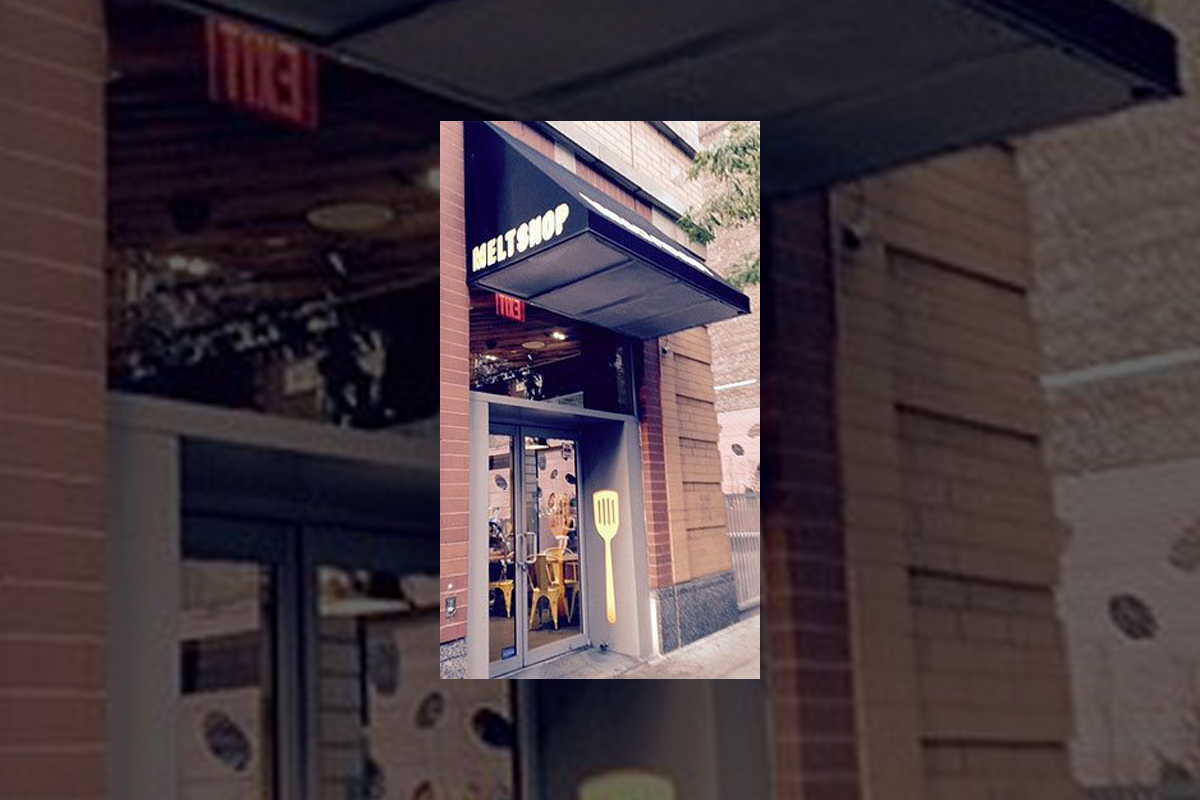
Greetings from NYC. Nancy and I drove down from New
Hampshire yesterday because we'll be checking out
Disney Consumer Products' annual Holiday Showcase later today.
Anyway … After checking into our hotel (i.e., The Paul.
Which is located down in NYC's NoMad district), we decided to grab some dinner.
Which is how we wound up at the Melt Shop.
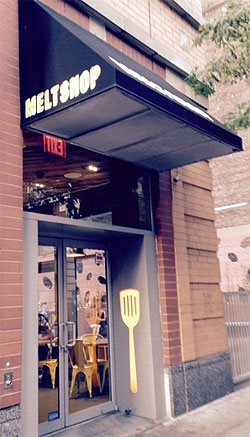
Photo by Jim Hill
Which is this restaurant that only sells grilled cheese sandwiches.
This comfort food was delicious, but kind of on the heavy side.
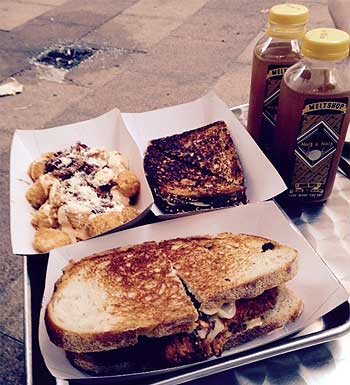
Photo by Jim Hill
Which is why — given that it was a beautiful summer night
— we'd then try and walk off our meals. We started our stroll down by the Empire
State Building
…
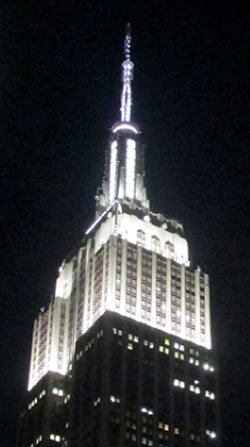
Photo by Jim Hill
… and eventually wound up just below Times
Square (right behind where the Waterford Crystal Times Square New
Year's Eve Ball is kept).

Photo by Jim Hill
But you know what we discovered en route? Right in the heart
of Manhattan's Garment District
along Broadway between 36th and 41st? This incredibly cool series of life-like
and life-sized sculptures that Seward
Johnson has created.
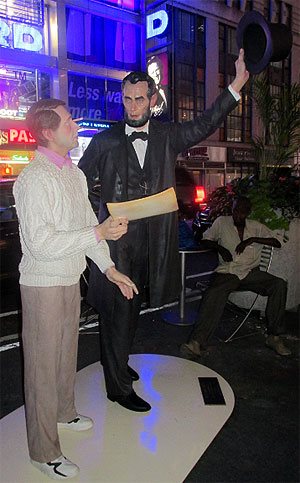
Photo by Jim Hill
And — yes — that is Abraham Lincoln (who seems to have
slipped out of WDW's Hall of Presidents when no one was looking and is now
leading tourists around Times Square). These 18 painted
bronze pieces (which were just installed late this past Sunday night / early
Monday morning) range from the surreal to the all-too-real.
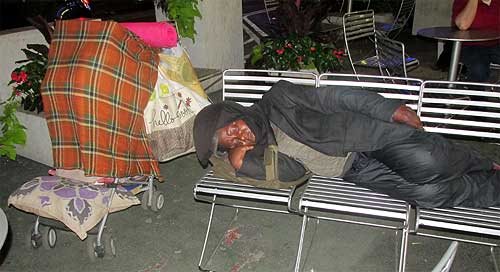
Photo by Jim Hill
Some of these pieces look like typical New Yorkers. Like the
business woman planning out her day …

Photo by Jim Hill
… the postman delivering the mail …
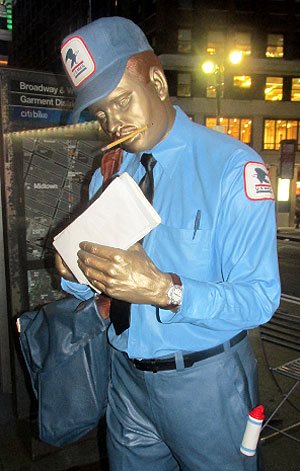
Photo by Jim Hill
… the hot dog vendor working at his cart …
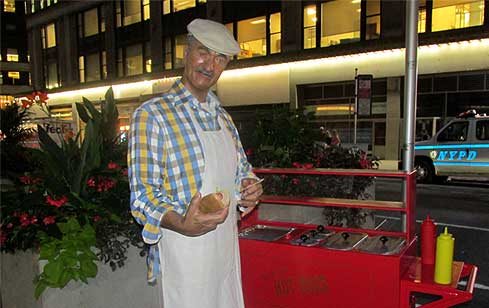
Photo by Jim Hill
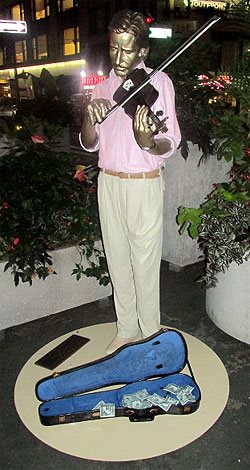
Photo by Jim Hill
… the street musician playing for tourists …
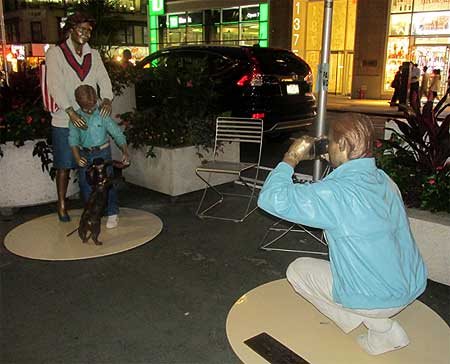
Photo by Jim Hill
Not to mention the tourists themselves.
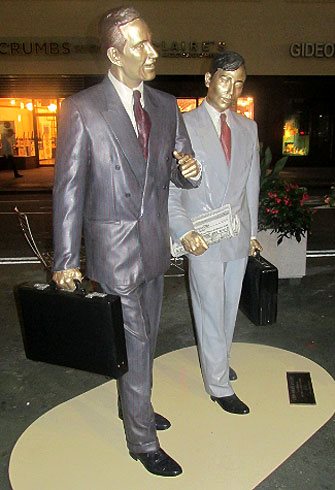
Photo by Jim Hill
But right alongside the bronze businessmen …
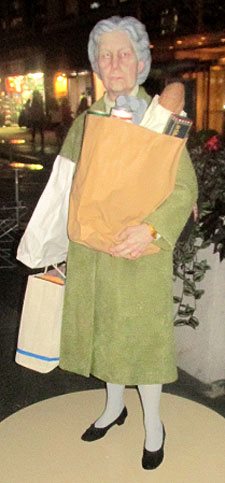
Photo by Jim Hill
… and the tired grandmother hauling her groceries home …
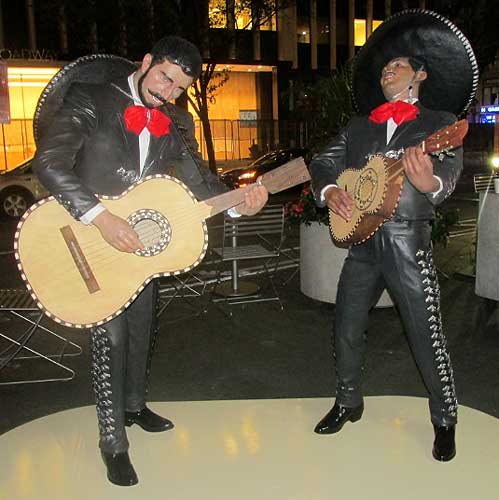
Photo by Jim Hill
… there were also statues representing people who were
from out-of-town …
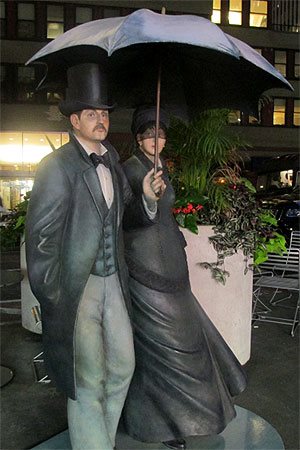
Photo by Jim Hill
… or — for that matter — out-of-time.
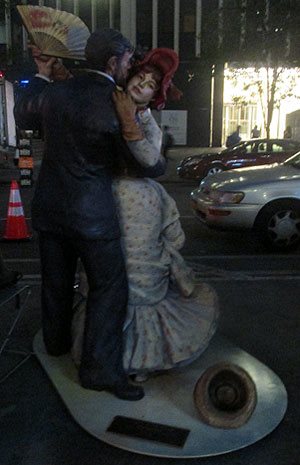
Photo by Jim Hill
These were the Seward Johnson pieces that genuinely beguiled. Famous impressionist paintings brought to life in three dimensions.
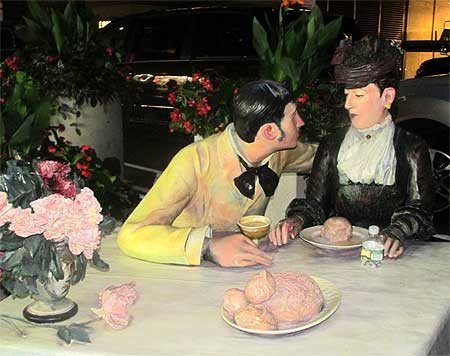
Note the out-of-period water bottle that some tourist left
behind. Photo by Jim Hill
Some of them so lifelike that you actually had to pause for
a moment (especially as day gave way to night in the city) and say to yourself
"Is that one of the bronzes? Or just someone pretending to be one of these
bronzes?"
Mind you, for those of you who aren't big fans of the
impressionists …
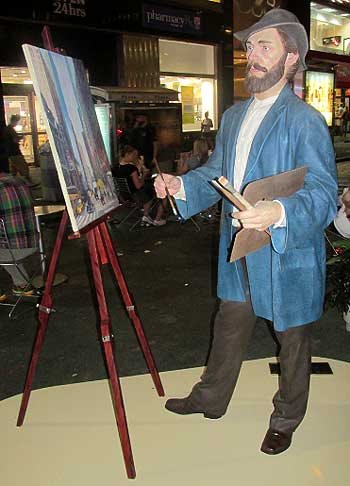
Photo by Jim Hill
… there's also an array of American icons. Among them
Marilyn Monroe …
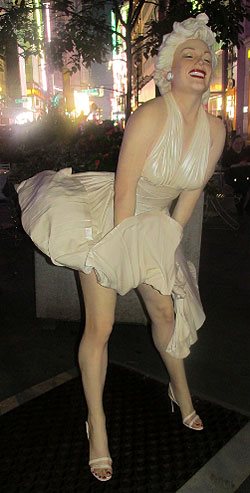
Photo by Jim Hill
… and that farmer couple from Grant Wood's "American
Gothic."
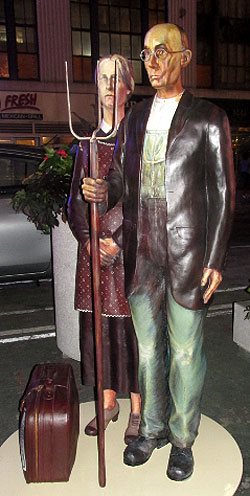
Photo by Jim Hill
But for those of you who know your NYC history, it's hard to
beat that piece which recreates Alfred Eisenstaedt's famous photograph of V-J Day in Times Square.
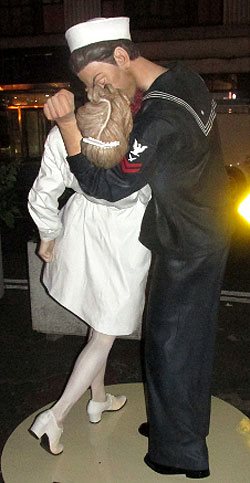
Photo by Jim Hill
By the way, a 25-foot-tall version of this particular Seward
Johnson piece ( which — FYI — is entitled "Embracing Peace") will actually
be placed in Times Square for a few days on or around August 14th to commemorate the 70th
anniversary of Victory Over Japan Day (V-J Day).
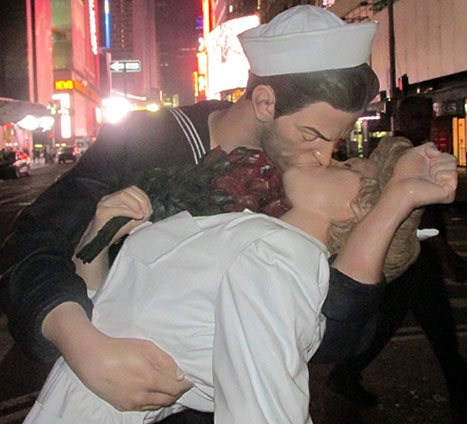
Photo by Jim Hill
By the way, if you'd like to check these Seward Johnson bronzes in
person (which — it should be noted — are part of the part of the Garment
District Alliance's new public art offering) — you'd best schedule a trip to
the City sometime over the next three months. For these pieces will only be on
display now through September 15th.
General
Wondering what you should “Boldly Go” see at the movies next year? The 2015 Licensing Expo offers you some clues
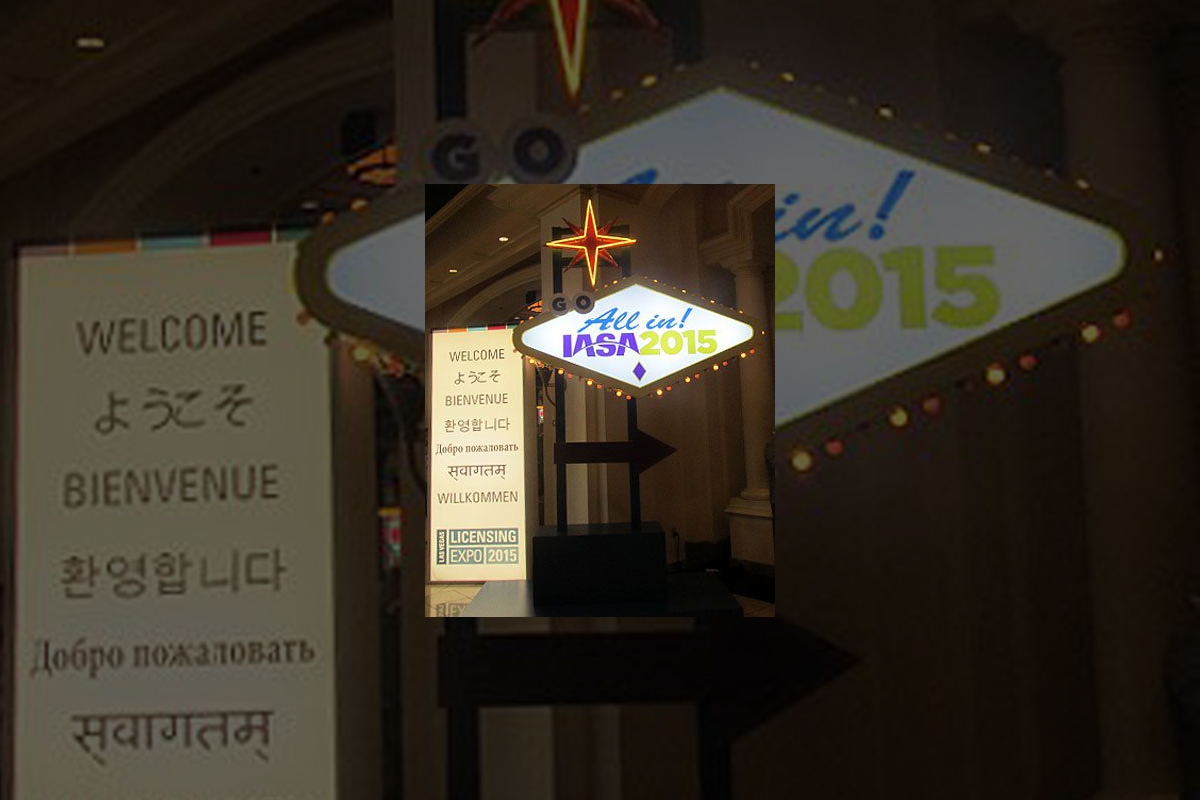
Greeting from the 2015 Licensing Expo, which is being held
at the Mandalay Bay
Convention Center in Las
Vegas.
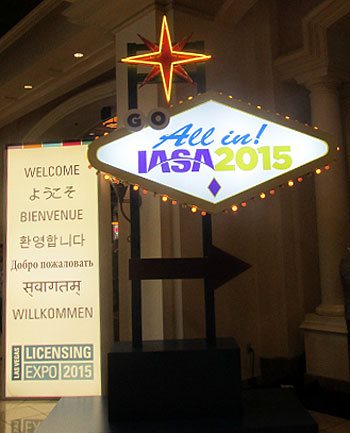
Photo by Jim Hill
I have to admit that I enjoy covering the Licensing Expo.
Mostly becomes it allows bloggers & entertainment writers like myself to
get a peek over the horizon. Scope out some of the major motion pictures &
TV shows that today's vertically integrated entertainment conglomerates
(Remember when these companies used to be called movie studios?) will be
sending our way over the next two years or so.
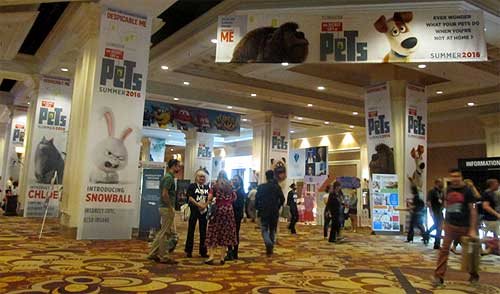
Photo by Jim Hill
Take — for example — all of "The Secret Life of
Pets" banners that greeted Expo attendees as they made their way to the
show floor today. I actually got to see some footage from this new Illumination
Entertainment production (which will hit theaters on July 8, 2016) the last time I was in Vegas. Which
was for CinemaCon back in April. And the five or so minutes of film that I viewed
suggested that "The Secret Life of Pets" will be a really funny
animated feature.
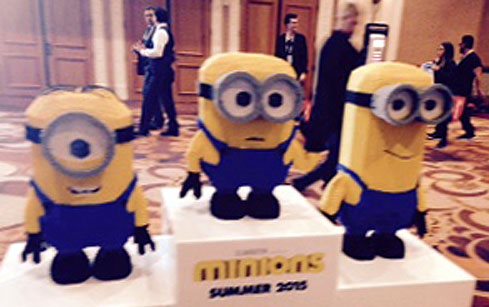
Photo by Jim Hill
Mind you, Universal Pictures wanted to make sure that Expo
attendees remembered that there was another Illumination Entertainment production
coming-to-a-theater-near-them before "The Secret Life of Pets" (And
that's "Minions," the "Despicable Me" prequel. Which
premieres at the Annecy International Animated Film Festival next week but
won't be screened stateside 'til July 10th of this year). Which is why they had
three minions who were made entirely out of LEGOS loitering out in the lobby.
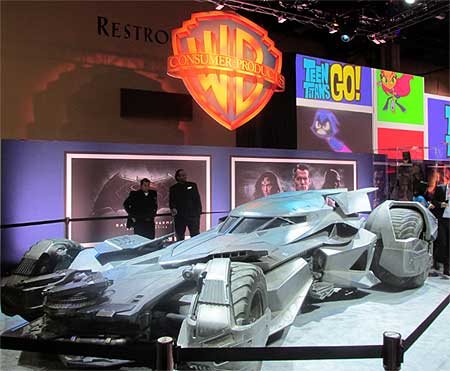
Photo by Jim Hill
And Warner Bros. — because they wanted "Batman v
Superman: Dawn of Justice" to start trending on Twitter today — brought
the Batmobile to Las Vegas.
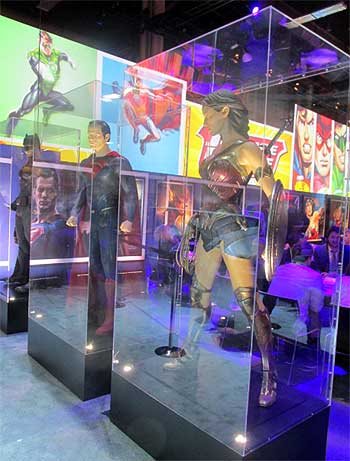
Photo by Jim Hill
Not to mention full-sized macquettes of Batman, Superman and
Wonder Woman. Just so conventioneers could then see what these DC superheroes
would actually look like in this eagerly anticipated, March 25, 2016 release.
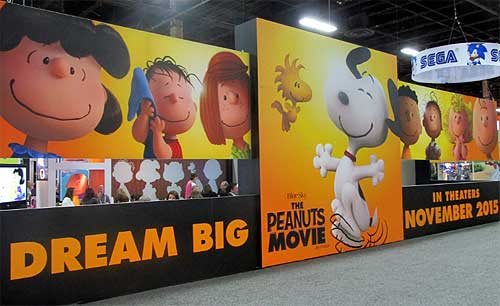
Photo by Jim Hill
That's the thing that can sometimes be a wee bit frustrating
about the Licensing Expo. It's all about delayed gratification. You'll come
around a corner and see this 100 foot-long ad for "The Peanuts Movie"
and think "Hey, that looks great. I want to see that Blue Sky Studios production
right now." It's only then that you notice the fine print and realize that
"The Peanuts Movie" doesn't actually open in theaters 'til November
6th of this year.
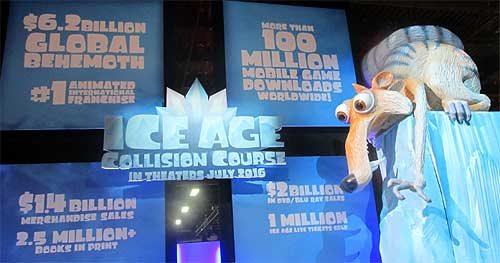
Photo by Jim Hill
And fan of Blue Sky's "Ice Age" film franchise are in for an even
longer wait. Given that the latest installment in that top grossing series
doesn't arrive in theaters 'til July
15, 2016.
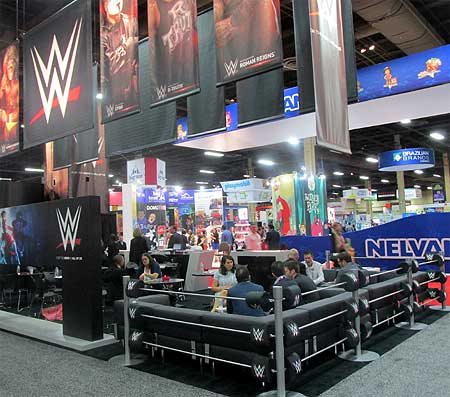
Photo by Jim Hill
Of course, if you're one of those people who needs immediate
gratification when it comes to your entertainment, there was stuff like that to
be found at this year's Licensing Expo. Take — for example — how the WWE
booth was actually shaped like a wrestling ring. Which — I'm guessing — meant
that if the executives of World Wrestling Entertainment, Inc. didn't like
the offer that you were making, they were then allowed to toss you out over the
top rope, Royal Rumble-style.
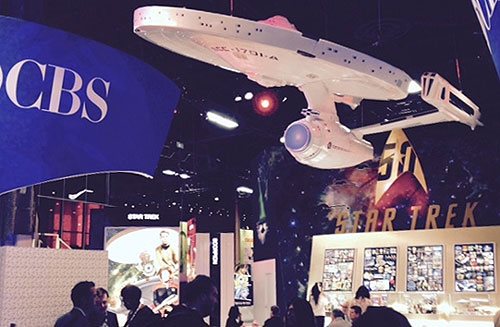
Photo by Jim Hill
I also have to admit that — as a longtime Star Trek fan —
it was cool to see the enormous Starship Enterprise that hung in place over the
CBS booth. Not to mention getting a glimpse of the official Star Trek 50th
Anniversary logo.
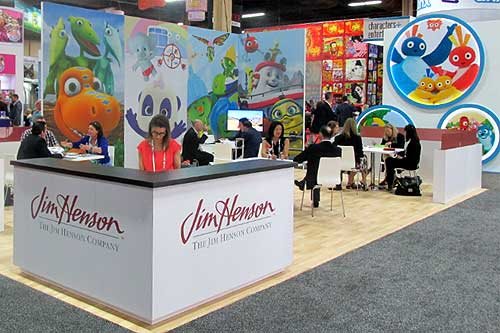
Photo by Jim Hill
I was also pleased to see lots of activity in The Jim Henson
Company booth. Which suggests that JHC has actually finally carved out a
post-Muppets identity for itself.

Photo by Jim Hill
Likewise for all of us who were getting a little concerned
about DreamWorks Animation (what with all the layoffs & write-downs &
projects that were put into turnaround or outright cancelled last year), it was
nice to see that booth bustling.
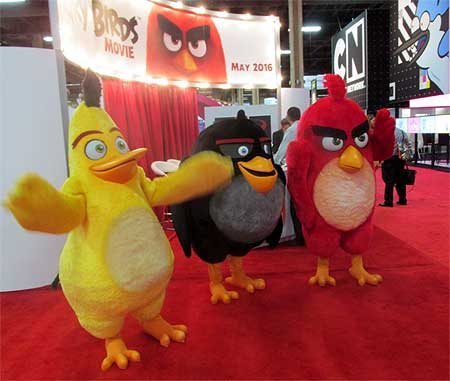
Photo by Jim Hill
Every so often, you'd come across some people who were
promoting a movie that you weren't entirely sure that you actually wanted to
see (EX: "Angry Birds," which Sony Pictures Entertainment / Columbia
Pictures will be releasing to theaters on May 20, 2016). But then you remembered that Clay Kaytis —
who's this hugely talented former Walt Disney Animation Studios animator — is
riding herd on "Angry Birds" with Fergal Reilly. And you'd think
"Well, if Clay's working on 'Angry Birds,' I'm sure this animated feature
will turn out fine."
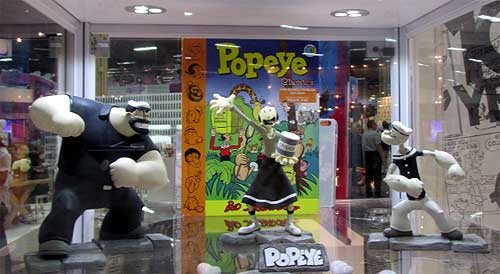
Photo by Jim Hill
Mind you, there were reminders at this year's Licensing Expo
of great animated features that we're never going to get to see now. I still
can't believe — especially after that brilliant proof-of-concept footage
popped up online last year — that Sony execs decided not to go forward
with production of Genndy Tartakovsky's
"Popeye" movie. But that's the
cruel thing about the entertainment business, folks. It will sometime break
your heart.
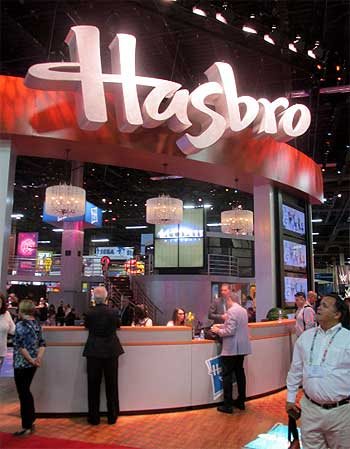
Photo by Jim Hill
And make no mistake about this. The Licensing Expo is all
about business. That point was clearly driven home at this year's show when —
as you walked through the doors of the Mandalay
Bay Convention Center
— the first thing that you saw was the Hasbros Booth. Which was this gleaming,
sleek two story-tall affair full of people who were negotiating deals &
signing contracts for all of the would-be summer blockbusters that have already
announced release dates for 2019 & beyond.
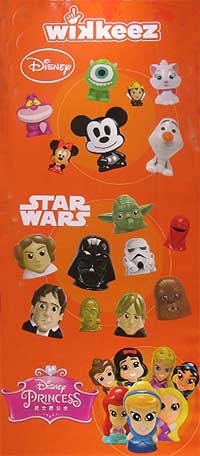
Photo by Jim Hill
"But what about The Walt Disney Company?," you
ask. "Weren't they represented on the show floor at this year's Licensing
Expo?" Not really, not. I mean, sure. There were a few companies there hyping
Disney-related products. Take — for example — the Disney Wikkeez people.
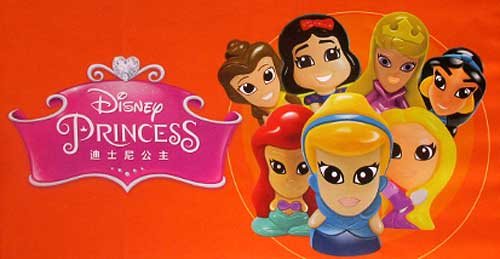
Photo by Jim Hill
I'm assuming that some Disney Consumer Products exec is
hoping that Wikkeez will eventually become the new Tsum Tsum. But to be blunt,
these little hard plastic figures don't seem to have the same huggable charm
that those stackable plush do. But I've been wrong before. So let's see what
happens with Disney Wikkeez once they start showing up on the shelves of the
Company's North American retail partners.
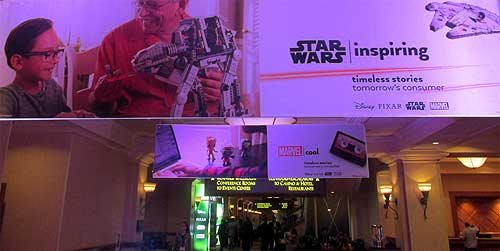
Photo by Jim Hill
And speaking of Disney's retail partners … They were
meeting with Mouse House executives behind closed doors one floor down from the
official show floor for this year's Licensing Expo.
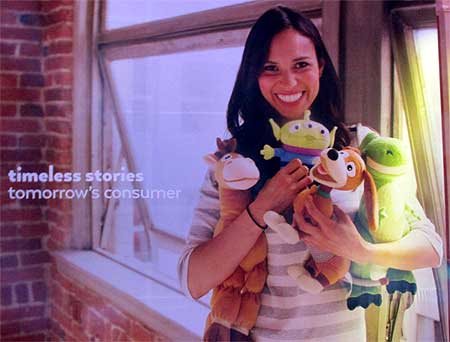
Photo by Jim Hill
And the theme for this year's invitation-only Disney shindig? "Timeless
Stories" involving the Disney, Pixar, Marvel & Lucasfilm brands that
would then appeal to "tomorrow's consumer."
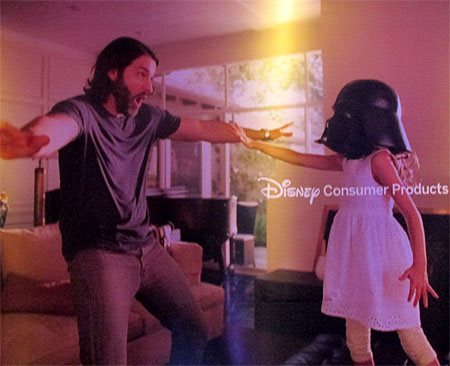
Photo by Jim Hill
And just to sort of hammer home the idea that Disney is no
longer the Company which cornered the market when it comes to little girls
(i.e., its Disney Princess and Disney Fairies franchises), check out this
wall-sized Star Wars-related image that DCP put up just outside of one of its
many private meeting rooms. "See?," this carefully crafted photo
screams. "It isn't just little boys who want to wield the Force. Little
girls also want to grow up and be Lords of the Sith."
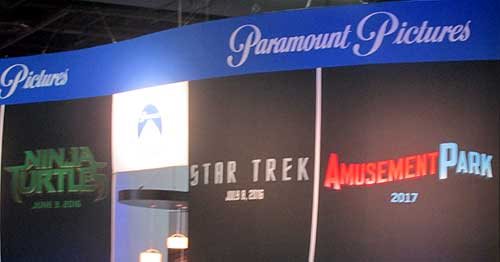
Photo by Jim Hill
One final, kind-of-ironic note: According to this banner,
Paramount Pictures will be releasing a movie called "Amusement Park"
to theaters sometime in 2017.
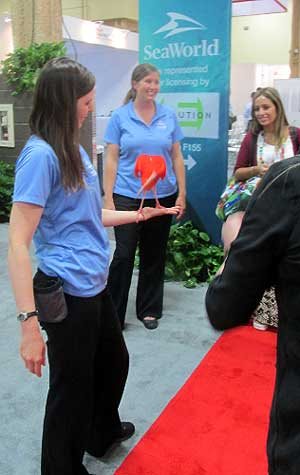
Photo by Jim Hill
Well, given all the "Blackfish" -related issues
that have been dogged SeaWorld Parks & Entertainment over the past two years, I'm
just hoping that they'll still be in the amusement park business come 2017.
Your thoughts?
General
It takes more than three circles to craft a Classic version of Mickey Mouse
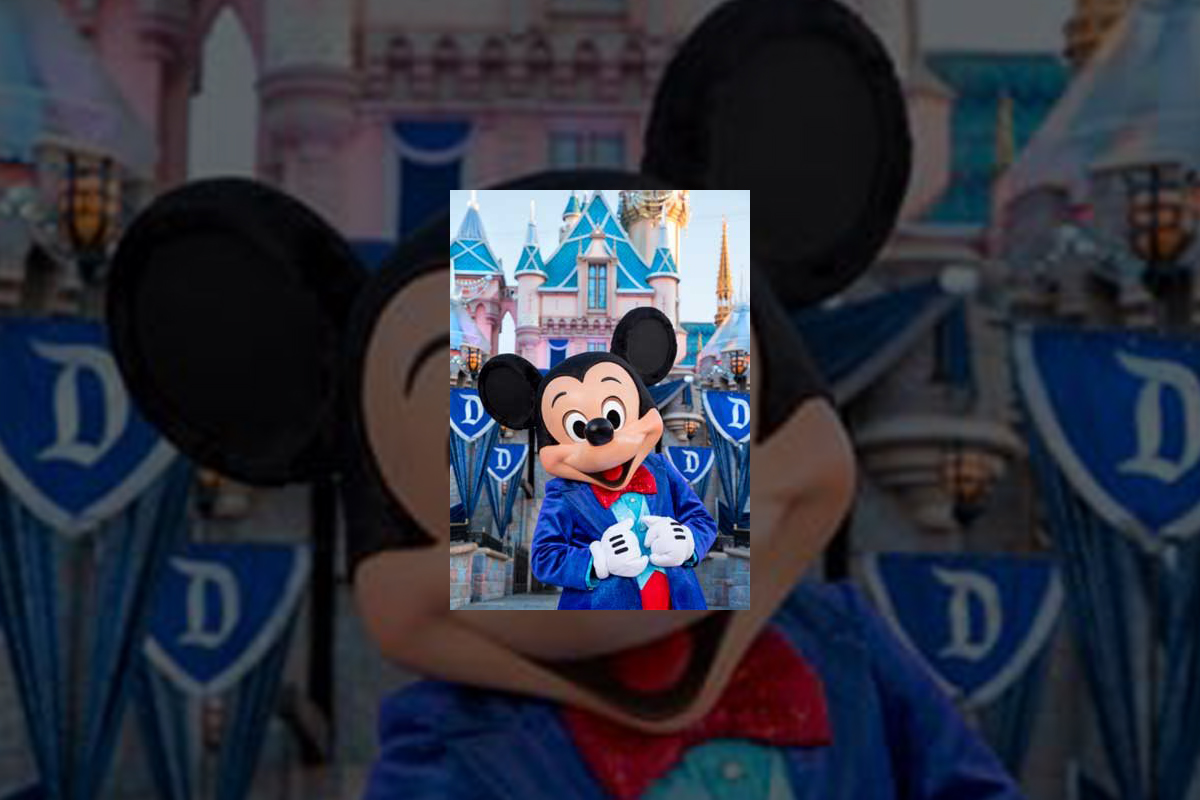
You know what Mickey Mouse looks like, right? Little guy,
big ears?
Truth be told, Disney's corporate symbol has a lot of
different looks. If Mickey's interacting with Guests at Disneyland
Park (especially this summer, when
the Happiest Place on Earth
is celebrating its 60th anniversary), he looks & dresses like this.
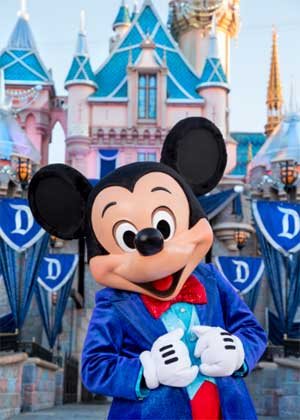
Copyright Disney Enterprises,
Inc.
All rights reserved
Or when he's appearing in one of those Emmy Award-winning shorts that Disney
Television Animation has produced (EX: "Bronco Busted," which debuts
on the Disney Channel tonight at 8 p.m. ET / PT), Mickey is drawn in a such a
way that he looks hip, cool, edgy & retro all at the same time.
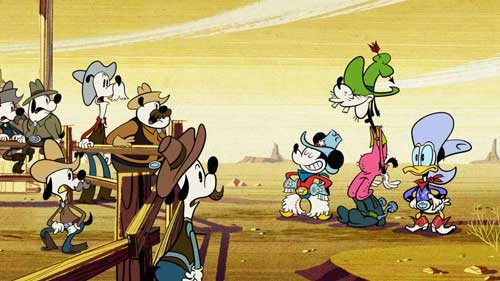
Copyright Disney Enterprises, Inc. All rights
reserved
Looking ahead to 2017 now, when Disney Junior rolls out "Mickey and the
Roadster Racers," this brand-new animated series will feature a sportier version
of Disney's corporate symbol. One that Mouse House managers hope will persuade
preschool boys to more fully embrace this now 86 year-old character.
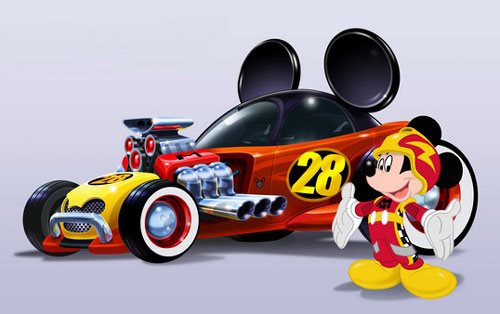
Copyright Disney Enterprises,
Inc. All rights reserved
That's what most people don't realize about the Mouse. The
Walt Disney Company deliberately tailors Mickey's look, even his style of
movement, depending on what sort of project / production he's appearing in.
Take — for example — Disney
California Adventure
Park's "World of Color:
Celebrate!" Because Disney's main mouse would be co-hosting this new
nighttime lagoon show with ace emcee Neil Patrick Harris, Eric Goldberg really had
to step up Mickey's game. Which is why this master Disney animator created
several minutes of all-new Mouse animation which then showed that Mickey was
just as skilled a showman as Neil was.
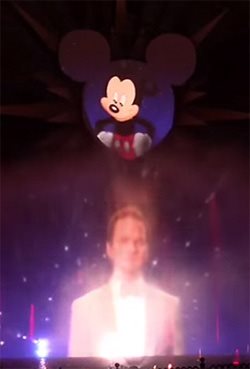
Copyright Disney Enterprises,
Inc.
All rights reserved
Better yet, let's take a look at what the folks at Avalanche Studios just went
through as they attempted to create a Classic version of Mickey & Minnie.
One that would then allow this popular pair to become part of Disney Infinity
3.0.
"I won't lie to you. We were under a lot of pressure to
get the look of this particular version of Mickey — he's called Red Pants
Mickey around here — just right," said Jeff Bunker, the VP of Art
Development at Avalanche Studios, during a recent phone interview. "When
we brought Sorcerer Mickey into Disney Infinity 1.0 back in January of 2014,
that one was relatively easy because … Well, everyone knows what Mickey Mouse
looked like when he appeared in 'Fantasia.' "
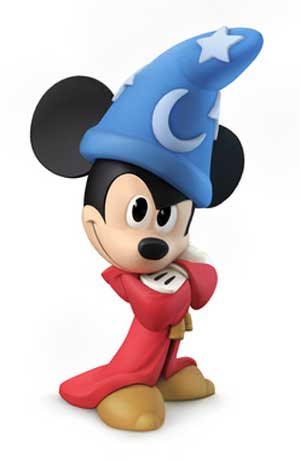
Copyright Disney Enterprises,
Inc. All rights reserved
"But this time around, we were being asked to design
THE Mickey & Minnie," Bunker continued. "And given that these Classic
Disney characters have been around in various different forms for the better
part of the last century … Well, which look was the right look?"
Which is why Jeff and his team at Avalanche Studios began watching hours &
hours of Mickey Mouse shorts. As they tried to get a handle on which look would
work best for these characters in Disney Infinity 3.0.
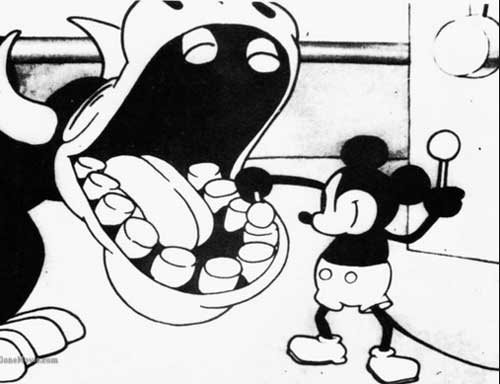
Copyright Disney
Enterprises, Inc. All rights reserved
"And we went all the way back to the very start of Mickey's career. We began
with 'Steamboat Willie' and then watched all of those black & white Mickey shorts
that Walt made back in the late 1920s & early 1930s. From there, we
transitioned to his Technicolor shorts. Which is when Mickey went from being
this pie-eyed, really feisty character to more of a well-behaved leading
man," Bunker recalled. "We then finished out our Mouse marathon by
watching all of those new Mickey shorts that Paul Rudish & his team have
been creating for Disney Television Animation. Those cartoons really recapture
a lot of the spirit and wild slapstick fun that Mickey's early, black &
white shorts had."
But given that the specific assignment that Avalanche Studios had been handed
was to create the most appealing looking, likeable version of Mickey Mouse
possible … In the end, Jeff and his team wound up borrowing bits & pieces
from a lot of different versions of the world's most famous mouse. So that
Classic Mickey would then look & move in a way that best fit the sort of
gameplay which people would soon be able to experience with Disney Infinity
3.0.
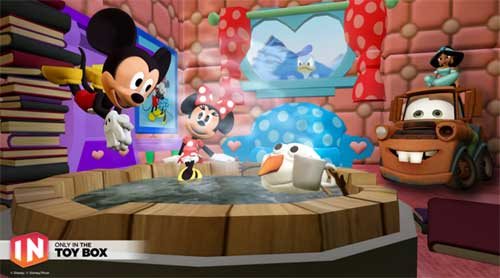
Copyright Disney Enterprises,
Inc. All rights reserved
"That — in a lot of ways — was actually the toughest
part of the Classic Mickey design project. You have to remember that one of the
key creative conceits of Disney Infinity
is that all the characters which appear in this game are toys," Bunker
stated. "Okay. So they're beautifully detailed, highly stylized toy
versions of beloved Disney, Pixar, Marvel & Lucasfilm characters. But
they're still supposed to be toys. So our Classic versions of Mickey &
Minnie have the same sort of thickness & sturdiness to them that toys have.
So that they'll then be able to fit right in with all of the rest of the
characters that Avalanche Studios had previously designed for Disney Infinity."
And then there was the matter of coming up with just the
right pose for Classic Mickey & Minnie. Which — to hear Jeff tell the
story — involved input from a lot of Disney upper management.
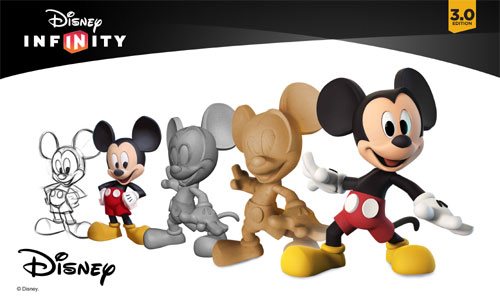
Copyright Disney Enterprises,
Inc. All rights reserved
"Everyone within the Company seemed to have an opinion
about how Mickey & Minnie should be posed. More to the point, if you Google
Mickey, you then discover that there are literally thousands of poses out there
for these two. Though — truth be told — a lot of those kind of play off the
way Mickey poses when he's being Disney's corporate symbol," Bunker said.
"But what I was most concerned about was that Mickey's pose had to work
with Minnie's pose. Because we were bringing the Classic versions of these
characters up into Disney Infinity 3.0 at the exact same time. And we wanted to
make sure — especially for those fans who like to put their Disney Infinity
figures on display — that Mickey's pose would then complement Minnie.
Which is why Jeff & the crew at Avalanche Studios
decided — when it came to Classic Mickey & Minnie's pose — that they
should go all the way back to the beginning. Which is why these two Disney icons
are sculpted in such a way that it almost seems as though you're witnessing the
very first time Mickey set eyes on Minnie.
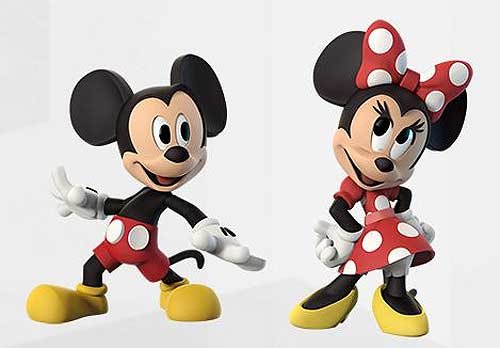
Copyright Disney Enterprises,
Inc. All rights reserved
"And what was really great about that was — as soon as
we began showing people within the Company this pose — everyone at Disney
quickly got on board with the idea. I mean, the Classic Mickey that we sculpted
for Disney Infinity 3.0 is clearly a very playful, spunky character. But at the
same time, he's obviously got eyes for Minnie," Bunker concluded. "So
in the end, we were able to come up with Classic versions of these characters
that will work well within the creative confines of Disney Infinity 3.0 but at
the same time please those Disney fans who just collect these figures because
they like the way the Disney Infinity characters look."
So now that this particular design project is over, does
Jeff regret that Mouse House upper management was so hands-on when it came to
making sure that the Classic versions of Mickey & Minnie were specifically
tailored to fit the look & style of gameplay found in Disney Infinity 3.0?
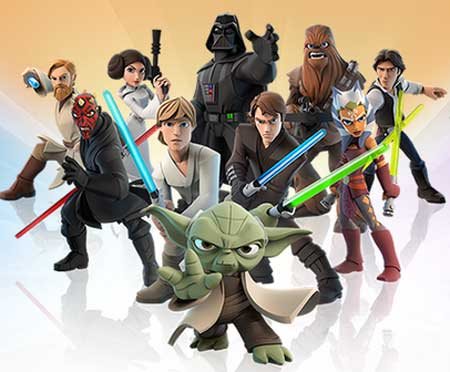
Copyright Lucasfilm / Disney
Enterprises, Inc. All rights reserved
"To be blunt, we go through this every time we add a new character to the
game. The folks at Lucasfilm were just as hands-on when we were designing the
versions of Darth Vader and Yoda that will also soon be appearing in Disney
Infinity 3.0," Bunker laughed. "So in the end, if the character's
creators AND the fans are happy, then I'm happy."
This article was originally posted on the Huffington Post's Entertainment page on Tuesday, June 9, 2015
-
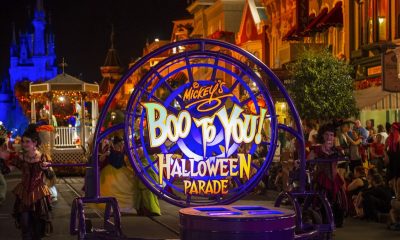
 Theme Parks & Themed Entertainment8 months ago
Theme Parks & Themed Entertainment8 months agoThe Story of Mickey’s Not-So-Scary Halloween Party: From One Night to a Halloween Family Tradition
-
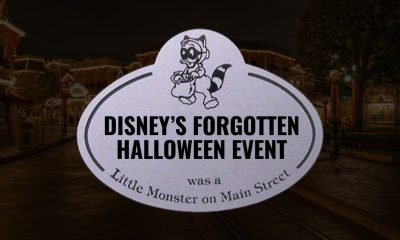
 Theme Parks & Themed Entertainment7 months ago
Theme Parks & Themed Entertainment7 months agoDisney’s Forgotten Halloween Event: The Original Little Monsters on Main Street
-
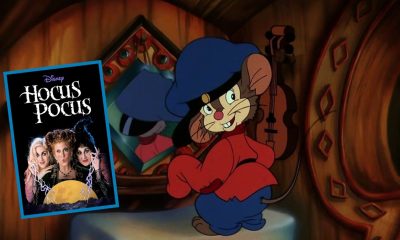
 Film & Movies7 months ago
Film & Movies7 months agoHow “An American Tail” Led to Disney’s “Hocus Pocus”
-
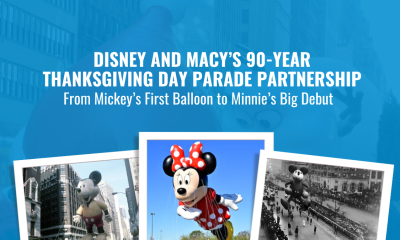
 Theme Parks & Themed Entertainment5 months ago
Theme Parks & Themed Entertainment5 months agoDisney and Macy’s 90-Year Thanksgiving Day Parade Partnership: From Mickey’s First Balloon to Minnie’s Big Debut
-
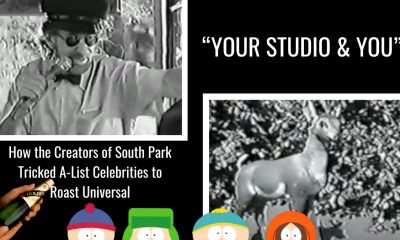
 Television & Shows3 months ago
Television & Shows3 months agoHow the Creators of South Park Tricked A-List Celebrities to Roast Universal – “Your Studio & You”
-

 History3 months ago
History3 months agoThe Super Bowl & Disney: The Untold Story Behind ‘I’m Going to Disneyland!’
-

 Podcast3 weeks ago
Podcast3 weeks agoEpic Universal Podcast – Aztec Dancers, Mariachis, Tequila, and Ceremonial Sacrifices?! (Ep. 45)
-
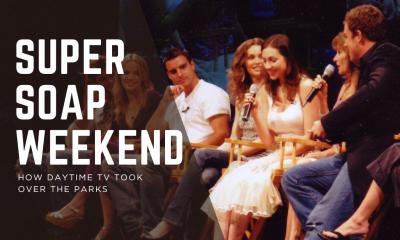
 Television & Shows2 days ago
Television & Shows2 days agoThe Untold Story of Super Soap Weekend at Disney-MGM Studios: How Daytime TV Took Over the Parks






